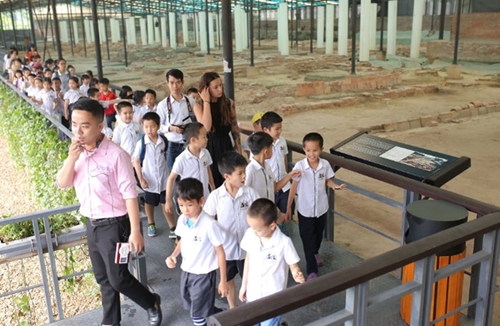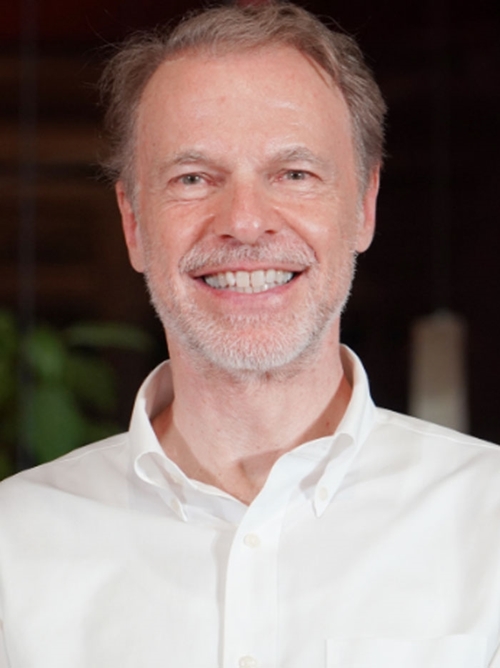The interview was on the occasion of UNESCO Director General Audrey Azoulay’s visit to Vietnam and attendance in the 50th anniversary of the Convention Concerning the Protection of the World Cultural and Natural Heritage (Convention) 1972 held in Ninh Binh province on September 6.
    |
 |
|
Students visit Imperial Citadel of Thang Long. |
The UNESCO official highlighted the importance of the birth of Convention 1972 which includes seven chapters and 38 articles, approved in November 1972. Mr. Christian Manhart shared that the convention came into effect after 20 first member countries ratified it in 1975 and first operational guidelines were approved in 1978.
As members of the convention, countries are responsible for ensuring the identification, protection, conservation, presentation and passing down to future generations of the world's cultural and natural heritage and pledge to not take deliberate measures that may directly or indirectly damage the world's cultural and natural heritage in their territory.
The UNESCO representative to Vietnam noted since Vietnam became a member of the Convention 1972 on October 19, 1987, it has been one of the most active members.
He underlined the S-shaped country’s activities such as boosting international cooperation to support the implementation of this convention through international professional cooperation, mobilization of financial resources via UNESCO, promotion of bilateral cooperation with Japan, France, India, the Republic of Korea, Italy, to name but a few. This is demonstrated through the building up dossiers and preparation of nomination dossiers, and the restoration of many Vietnamese important heritage. According to the UNESCO official, a number of relic sites damaged during the war have been restored and are open to the public. He mentioned the Complex of Hue Monuments and My Son Cham Relic Site.
He spoke highly of the Vietnamese government’s awareness of the value of world heritage for economic and social development and its great efforts made to promote a culture-based economy, improve living standards, and build the nation's brand.
He recalled that during the 2013-2017 period, Vietnam contributed to the improvement of mechanisms according to the convention. Vietnam hosted the international UNESCO experts’ meeting in January 2015, resulting in UNESCO’s adoption of policy on world heritage and sustainable development in 2015.
Vietnam has eight UNESCO-recognized world’s cultural and natural heritage elements, including five cultural, two natural and one mixed ones. Over the past years, the Government of Vietnam, relevant agencies, and local communities have actively preserved and promoted these world heritage elements. However, according to Mr. Christian Manhart, the management of world heritage is a more complicated duty.
Asked what Vietnamese should do to balance the protection of world heritage and economic development, Mr. Christian Manhart gave some suggestions. He said that economic development should not diminish the outstanding universal value of a place. The development goals for world heritage sites need to be revised to ensure quality and sustainability, not just visitor numbers. The risk is that the infrastructure is developed to increase the number of tourists without assessment of the place, or the local culture. If growth continues at a similar rate on some websites, in the long run, the rate of web access will decrease and that is unlikely to reverse.
Vietnam should ensure that regulations do not conflict with each other that make heritage management impossible, for example existing laws and regulations on world heritage sites; on construction and traffic; and on public investment and tourism, he advised.
    |
 |
|
UNESCO representative in Vietnam Christian Manhart |
He said that it is important to promote the role of technical advisory bodies. He highlighted evidence-based strategic advice to the government of the National Heritage Council whose staff are leading academics. He also highly appreciated the establishment of scientific advisory bodies at relic site, mentioning the case with the Imperial Citadel of Thang Long. He stressed that the establishment of a national commission under the International Council of Monuments and Sites will allow the country to participate in and benefit from the largest international heritage network.
He noticed that some development projects in or near world heritage sites like Hoi An and Ha Long Bay are rushing to find short-term opportunities. This is a dilemma, in terms of not only the risks to heritage preservation and the displacement of local culture, but also the questionability of the long-term economic sustainability of the project itself. Therefore, he reminded Vietnam to pay more attention to high-quality, low-impact initiatives through building a strong sustainability framework to guide investments in cultural and natural sites.
UNESCO representative in Vietnam Christian Manhart emphasized that UNESCO highly praised the active engagement and support of the Vietnamese Government, cities and provinces nationwide, managers of relic sites and world heritage sites in organizing an anniversary of the Convention 1972.
Regarding this celebration in Ninh Binh with the participation of UNESCO Director General, Mr. Manhart said that it is important to attract more attention and support of the public for the heritage preservation work. The celebration is a highlight to put Vietnam at the center of international attention in heritage field.
He said that a strong message sent to this special occasion is the shared interest between Vietnam and UNESCO and that Vietnam is an active and responsible member in efforts to protect and promote world’s cultural and natural heritage.
Translated by Chung Anh